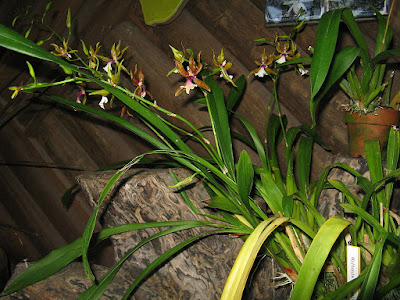Miltonia clowesii is native to Brazil. This species occurs in the Organ Mountains and colder mountain areas in the states of Espírito Santo, Rio de Janeiro and Minas Gerais. In the state of Espírito Santo, they are found near Cachoeiro de Itapemirim at an altitude of around 800 m...
Miltonia clowesii also called as Clowes' Miltonia, Brassia clowesia, Miltonia clowesii var. lamarcheana, Ontoglossum clowesii, Oncidium clowesii, is a species of the genus Miltonia. This species was described by John Lindley in 1840.
IDENTIFY MILTONIA CLOWESII
Miltonia clowesii is native to Brazil. This species occurs in the Organ Mountains and colder mountain areas in the states of Espírito Santo, Rio de Janeiro and Minas Gerais. In the state of Espírito Santo, they are found near Cachoeiro de Itapemirim at an altitude of around 800 m.
It is a large sized, cool to warm growing epiphyte, which reaching 38-56 cm in size, with narrowly oblong-ovate, compressed, 7-10 cm long pseudobulbs carrying 2, apical, linear-ligulate, subacute, yellow green, 22-45 cm long leaves.
Clowes' Miltonia blooms on a racemose, axillary from the base of the pseudobulb, slender, erect or arching, 60 cm long inflorescence that has 7 to 10 successively opening flowers occurring in the fall. The flowers are 5-8 cm in diameter and open successively, so the plant is able to flower for a long period of time. Sharp-ended, widely spread petals of both whorls are yellow with nut-brown horizontal lines and spots. The long, sharp tip of the violin-shaped lip is white on the upper half and purple-purple on the bottom, where it is additionally decorated with 5-7 convex lines. These lines can be from white to yellow and are of different lengths. The centerline is the widest, and the adjacent sideways are the longest.
MILTONIA CLOWESII CARE AND CULTURE
Cultural information should only be used as a guide, and should be to be adapted to suit you. Your physical location; where you grow your plants, how much time you have to devote to their care, and many other factors, will need to be taken into account. Only then can you decide on the cultural methods that best suit you and your plants.
Light:
Miltonia clowesii needs a light level of 15000-20000 lux.
Temperature:
The average temperature of the summer day is 24-26 ° C, night 18 ° C, giving a daily difference of 7-8 ° C. The average temperature of the winter day is 20-21 ° C, the night 13-14 ° C, which gives a daily difference of 7 ° C.
Humidity:
Clowes' Miltonia needs the humidity of 80-85% throughout the year.
Substrate, growing media and repotting:
These plants are generally grown in pots. A loose, fast-drying substrate is required, but also a retaining part of the water.
Watering:
This species should often be watered during active growth, but it should not be allowed to dry completely between waterings. After the end of flowering in autumn, the amount of water should be gradually reduced.
Fertilizer:
During the active growth of the plants should be fertilized every week 1/4-1/2 of the recommended dose of fertilizer for orchids.
Rest period:
In winter, Miltonia clowesii need to reduce the amount of water, but they can never dry up completely. In most cases, the appropriate conditions will ensure occasional morning fogging and light watering every two weeks, especially when the sunny weather begins. Fertilization should be eliminated until new growth occurs in spring, when more watering is undertaken.















COMMENTS